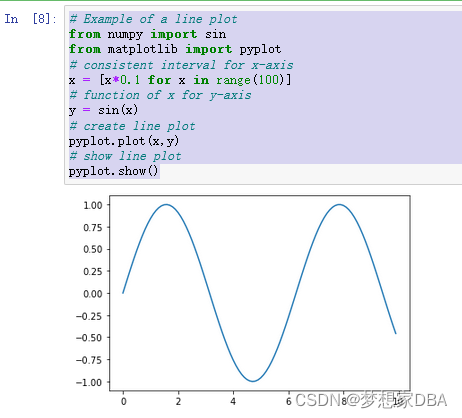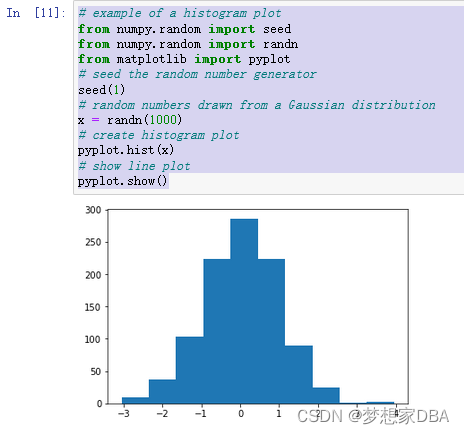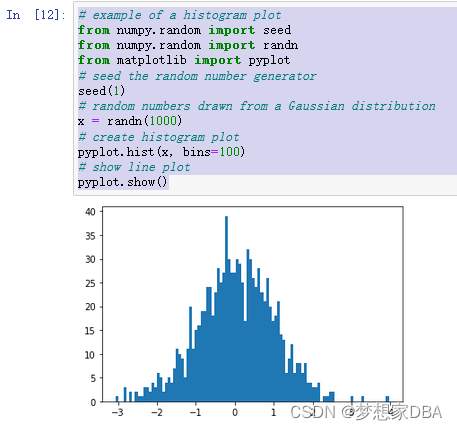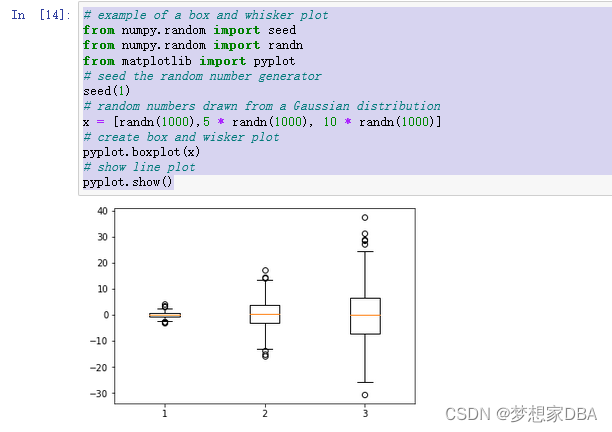After learn it , you will know
- How to chart time series data with line plots and categorical quantities with bar charts.
- How to summarize data distributions with histograms and box plots
- How to summarize the relationship between variables with scatter plots.
1.1 Tutorial Overview
- Data Visualization
- Introduction to Matplotlib
- Line Plot
- Bar Chart
- Histogram Plot
- Box and Whisker Plot
- Scatter Plot
1.2 Data Visualization
Data visualization is an important skill in applied statistics and machine learning. Statistics does indeed focus on quantitative descriptions and estimations of data. Data visualization provides an important suite of tools for gaining a qualitative understanding.With a little domain knowledge, data visualizations can be used to express and demonstrate key relationships in plots and charts that are more visceral to yourself and stakeholders than measures of association or significance.There are five key plots that you need to know well for basic data visualization. They are the Line Plot, Bar Chart, Histogram Plot, Box and Whisker Plot, and the Scatter Plot. With a knowledge of these plots, you can quickly get a qualitative understanding of most data that you come across.
1.3 Introduction to Matplotlib
The Matplotlib library is the foundation for many other plotting libraries and plotting support in higher-level libraries such as Pandas. The Matplotlib provides a context, one in which one or more plots can be drawn before the image is shown or saved to file. The context can be accessed via functions on pyplot. The context can be imported as follows:
# important matplotlib context
from matplotlib import pyplotThere is some convention to import this context and name it plt.
# import matplotlib context
import matplotlib.pyplot as plt. Charts and plots are made by making and calling on context;
# create a plot
pyplot.plot(...)The drawings on the context can be shown in a new window by calling the show() function:
# display the plot
pyplot.show()Alternately, the drawings on the context can be saved to file, such as a PNG formatted image file. The savefig() function can be used to save images.
# save plot to file
pyplot.savefig('my_image.png')1.4 Line Plot(线绘图、折线图)
A line plot is generally used to present observations collected at regular intervals. The x-axis represents the regular interval, such as time. The y-axis shows the observations, ordered by the x-axis and connected by a line. A line plot can be created by calling the plot() function and passing the x-axis data for the regular interval, and y-axis for the observations.
# create line plot
pyplot.plot(x, y)Line plots are useful for presenting time series data as well as any sequence data where there is an ordering between observations. The example below creates a sequence of 100 floating point values as the x-axis and a sine wave as a function of the x-axis as the observations on the y-axis. The results are plotted as a line plot.
# Example of a line plot
from numpy import sin
from matplotlib import pyplot
# consistent interval for x-axis
x = [x*0.1 for x in range(100)]
# function of x for y-axis
y = sin(x)
# create line plot
pyplot.plot(x,y)
# show line plot
pyplot.show()Running the example creates a line plot showing the familiar sine wave pattern on the y-axis across the x-axis with a consistent interval between observations.

1.5 Bar Chart(柱状图)
A bar chart is generally used to present relative quantities for multiple categories. The x-axis represents the categories and are spaced evenly. The y-axis represents the quantity for each category and is drawn as a bar from the baseline to the appropriate level on the y-axis. A bar chart can be created by calling the bar() function and passing the category names for the x-axis and the quantities for the y-axis.
# create bar chart
pyplot.bar(x,y)Bar charts can be useful for comparing multiple point quantities or estimations. The example below creates a dataset with three categories, each defined with a string label. A single random integer value is drawn for the quantity in each category.
# example of a bar chart
from random import seed
from random import randint
from matplotlib import pyplot
# seed the random number generator
seed(1)
# names for categories
x = ['red','green','blue']
# quantities for each category
y = [randint(0,100),randint(0,100),randint(0, 100)]
# create bar chart
pyplot.bar(x, y)
# show line plot
pyplot.show()1.6 Histogram Plot(直方图)
A histogram plot is generally used to summarize the distribution of a data sample. The x-axis represents discrete bins or intervals for the observations. For example observations with values between 1 and 10 may be split into five bins, the values [1,2] would be allocated to the first bin,3,4] would be allocated to the second bin, and so on. The y-axis represents the frequency or count of the number of observations in the dataset that belong to each bin. Essentially, a data sample is transformed into a bar chart where each category on the x-axis represents an interval of observation values.
A histogram plot can be created by calling the hist() function and passing in a list or array that represents the data sample.
# example of creating a histogram plot
# create histogram plot
pyplot.hist(x)Histograms are valuable for summarizing the distribution of data samples. The example below creates a dataset of 1,000 random numbers drawn from a standard Gaussian distribution, then plots the dataset as a histogram.
# example of a histogram plot
from numpy.random import seed
from numpy.random import randn
from matplotlib import pyplot
# seed the random number generator
seed(1)
# random numbers drawn from a Gaussian distribution
x = randn(1000)
# create histogram plot
pyplot.hist(x)
# show line plot
pyplot.show()Running the example, we can see that the shape of the bars shows the bell-shaped curve of the Gaussian distribution. We can see that the function automatically chose the number of bins, in this case splitting the values into groups by integer value.

Often, careful choice of the number of bins can help to better expose the shape of the data distribution. The number of bins can be specified by setting the bins argument; for example:
# example of a histogram plot
from numpy.random import seed
from numpy.random import randn
from matplotlib import pyplot
# seed the random number generator
seed(1)
# random numbers drawn from a Gaussian distribution
x = randn(1000)
# create histogram plot
pyplot.hist(x, bins=100)
# show line plot
pyplot.show()
1.7 Box and Whisker Plot(箱线图)
A box and whisker plot, or boxplot for short, is generally used to summarize the distribution of a data sample. The x-axis is used to represent the data sample, where multiple boxplots can be drawn side by side on the x-axis if desired.The y-axis represents the observation values.
Boxplots can be drawn by calling the boxplot() function passing in the data sample as an array or list.
# create box and whisker plot
pyplot.boxplot(x)Boxplots are useful to summarize the distribution of a data sample as an alternative to the histogram. They can help to quickly get an idea of the range of common and sensible values in the box and in the whisker respectively. Because we are not looking at the shape of the distribution explicitly, this method is often used when the data has an unknown or unusual distribution, such as non-Gaussian.
# example of a box and whisker plot
from numpy.random import seed
from numpy.random import randn
from matplotlib import pyplot
# seed the random number generator
seed(1)
# random numbers drawn from a Gaussian distribution
x = [randn(1000),5 * randn(1000), 10 * randn(1000)]
# create box and wisker plot
pyplot.boxplot(x)
# show line plot
pyplot.show()Running the example creates a chart showing the three box and whisker plots. We can see that the same scale is used on the y-axis for each, making the first plot look squashed and the last plot look spread out. In this case, we can see the black box for the middle 50% of the data, the orange line for the median, the lines for the whiskers summarizing the range of sensible data, and finally dots for the possible outliers.

1.8 Scatter Plot(散点图)
A scatter plot, or scatterplot, is generally used to summarize the relationship between two paired data samples. Paired data samples means that two measures were recorded for a given observation, such as the weight and height of a person. The x-axis represents observation values for the first sample, and the y-axis represents the observation values for the second sample. Each point on the plot represents a single observation.
Scatter plots can be created by calling the scatter() function and passing the two data sample arrays.
# create scatter plot
pyplot.scatter(x, y)Scatter plots are useful for showing the association or correlation between two variables. A correlation can be quantified, such as a line of best fit, that too can be drawn as a line plot on the same chart, making the relationship clearer. A dataset may have more than two measures (variables or columns) for a given observation. A scatter plot matrix is a cart containing scatter plots for each pair of variables in a dataset with more than two variables. The example below creates two data samples that are related. The first is a sample of random numbers drawn from a standard Gaussian. The second is dependent upon the first by adding a second random Gaussian value to the value of the first measure.
# example of a scatter plot
from numpy.random import seed
from numpy.random import randn
from matplotlib import pyplot
# seed(1)
# first variable
x = 20 * randn(1000) + 100
# second variable
y = x + (10 * randn(1000) + 50)
# create scatter plot
pyplot.scatter(x, y)
# show line plot
pyplot.show()






















 964
964











 被折叠的 条评论
为什么被折叠?
被折叠的 条评论
为什么被折叠?








